It’s three weeks since George Floyd, an unarmed black man, was killed by police in Minneapolis. It’s three weeks since the world woke up to the fact that it wasn’t enough to be passively “not racist” but that it needed to be actively anti-racist. And it’s three days since the writer Reni Eddo-Lodge became the first black British woman to take the No1 spot in the UK’s official book charts with her Why I’m No Longer Talking To White People About Race.
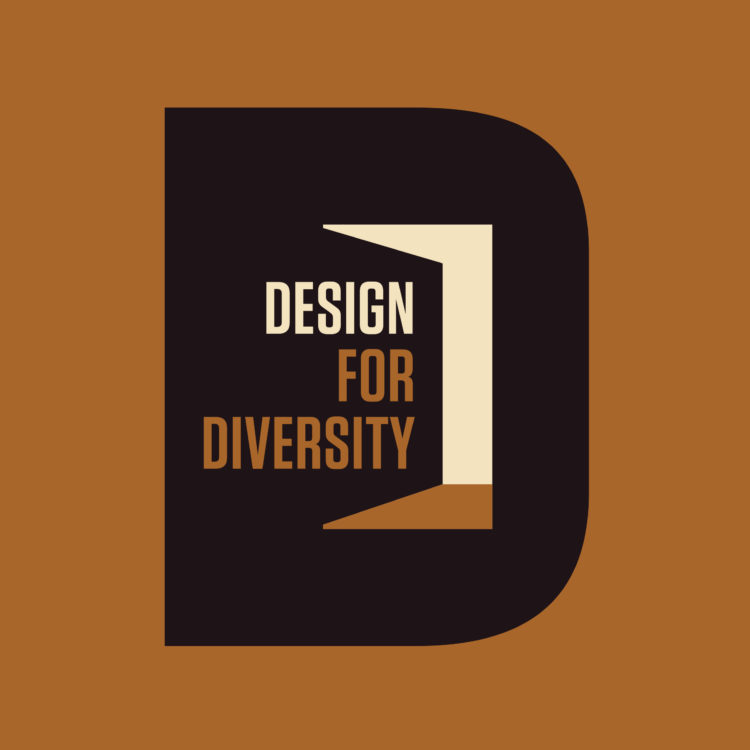
The interiors community is, like many others, in a state of shock. It has been called out for its lack of representation, its failure to hire, or even interview Black and PoC candidates, to include them at events, in social feeds and on websites.
Over the last three weeks there has been a global realisation that things need to change. The world has finally woken up to systemic racism apparent in so many of its organisations and institutions.
The black community is feeling rejected, excluded and under-represented. The white community is simultaneously shocked, panicked and wondering what to do.
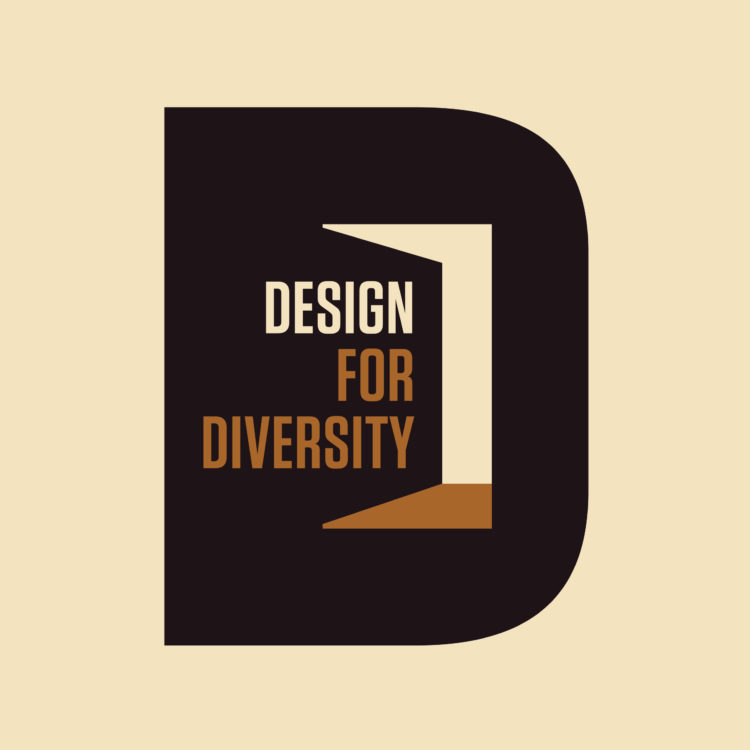
Among the interiors community, there’s been a lot of quiet reflection, a certain amount of shouting, a great deal of guilt, and many promises to do better. But so far there has been little concrete. Some have disappeared behind promises to conduct internal reviews, some put out statements promising to do better before disappearing. Some just disappeared. And the black community took note of all the black squares on Instagram and said: “What now?”
I started chatting to Rukmini Patel, a British Indian interior designer, on a Saturday afternoon two weeks ago. She and I had both written posts on the lack of diversity in interiors (me) and how to create diversity in the interiors industry (her) on 4 June, two days after Blackout Tuesday. I had received many supportive messages from within the black community following the podcast episode I recorded with Sophie Robinson where we asked Black, Asian and Minority Ethnic voices to share their experiences and thoughts on the lack of diversity within the interiors industry. Rukmini had heard from white-owned brands and businesses who were desperate to work towards a change, but didn’t know where to start.
And so, during the course of a very long Instagram chat, Rukmini and I came up with the idea of a sticker. A sticker that anyone can put on their site and that clicks through to a pledge. A simple pledge to do better:
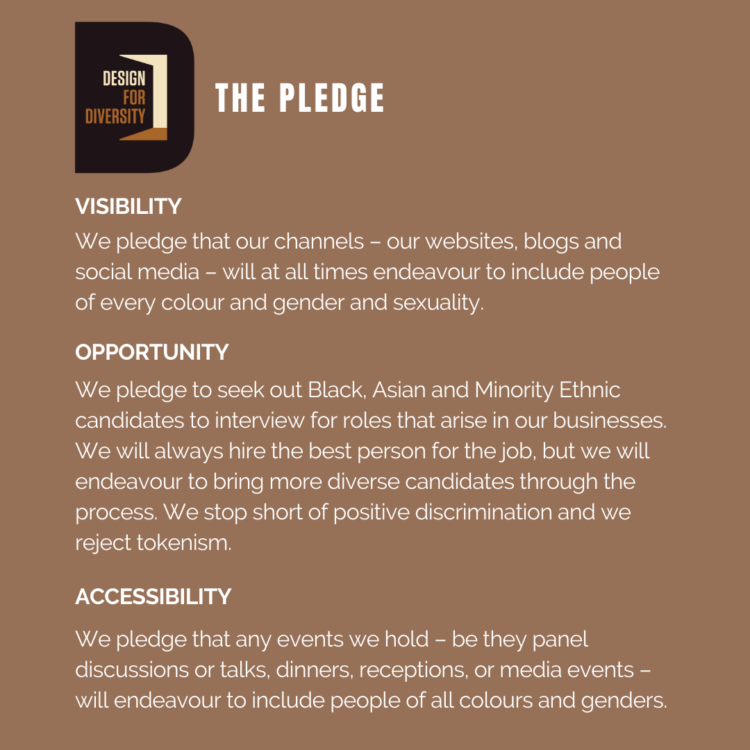
We do not claim it as a solution. But we offer it as the start of a conversation. A sign that the door is open.
We have talked to dozens of people from many communities over the last three weeks. One of the most widely raised issues is that of under-representation. A feeling that if you don’t see people who look like you in a company, you won’t approach them for a job, an internship, work experience, or even, in many cases, a career. Others spoke of applying and learning they had been turned down on account of the colour of their skin, or even an unusual name (please listen to the podcast 11 June 2020 if you find that hard to believe).
It’s our sincere hope that the presence of this sticker on a design website or social channel will give those who see it the confidence to take a step forward, while offering reassurance that their interest will be received with positivity and fairness. And that, on seeing it, a young black designer might feel confident enough to approach a company and offer their products for sale, or to ask for work experience, or respond to a job advertisement.
At the same time, the sticker is designed to show recognition that it’s a two-way street; that companies need to also go out and find applicants from the BAME community to bring into their organisations.
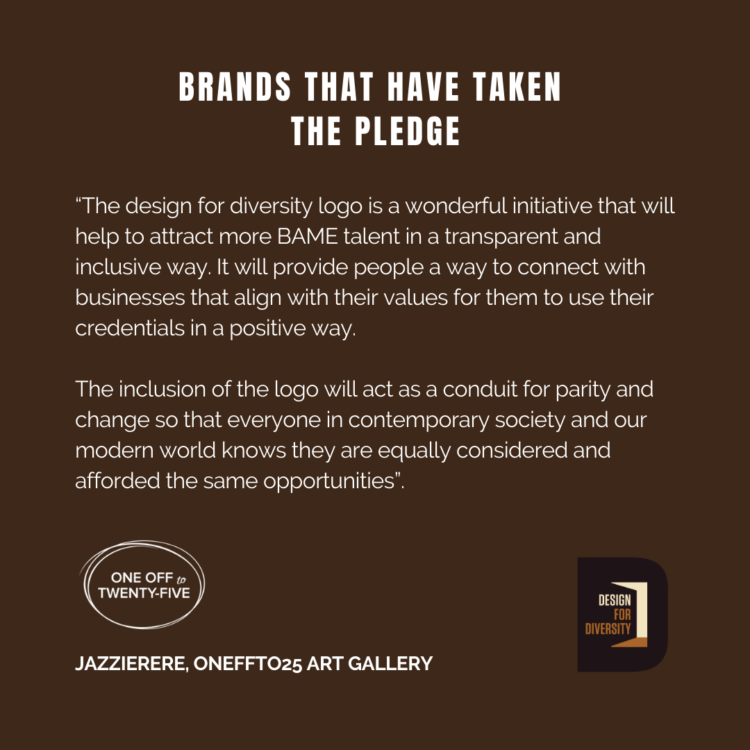
Victoria Ruffy, founder of Little Red PR, told me that a few months ago after receiving no Black or PoC applicants for a vacancy, she set out to find them herself.
“Running a PR agency headquartered in Berkshire for almost 10 years, I am always on the hunt for PR superstars. We were recently struggling with applicants and have had limited success with recruitment agencies, so I decided to reach out directly to potential candidates on LinkedIn. Many marketing / PR / English grads in our local area were from the BAME community but we very, very rarely have applicants who aren’t white.
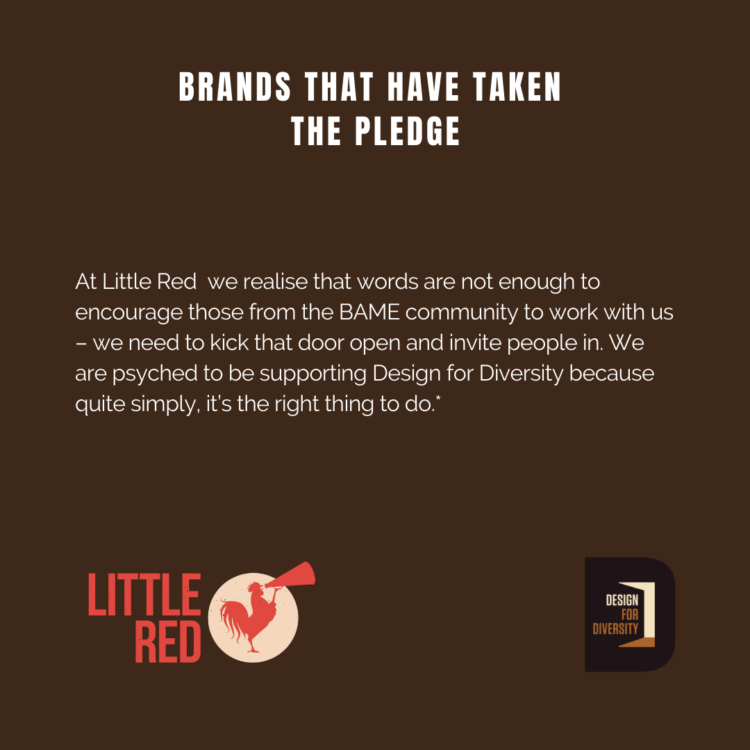
“By actively approaching these potential candidates I found they were super receptive to a role with us – really responsive on Messenger, had super CVs with great portfolios. We were arranging a graduate recruitment day before lockdown (which has now been postponed until August) and I am so pleased that the line-up of potential candidates includes over 50 per cent from the BAME community. But, I had to be proactive to make this happen. What I’ve learnt is that it’s not enough to just say “all are welcome”. We need to kick open that front door and invite people in.
“This process opened my eyes to how intimidating it is for any graduate, let alone one who may feel sidelined by the wider community, and as such it’s shown me I need to take an active role in promoting inclusivity within my company, the clients we represent, the team I manage, and the industry as a whole. With that I am psyched to be supporting Design for Diversity.”
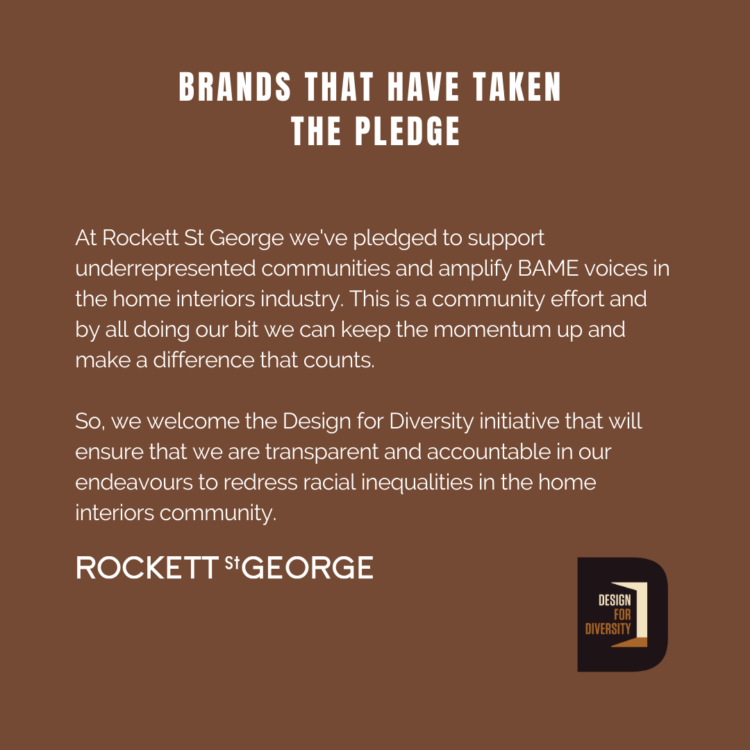
So we hope this sticker will be a start in an ongoing conversation about how to build on these three simple pledges. We are so excited that Heals, Rockett St George, Pooky, Audenza and Oneoffto25 have all come board already. Please see the images for their quotes. And The Times newspaper will be running a small story in Friday’s Bricks & Mortar (Saturday in Print).
Hamish Mansbridge, the CEO of Heal’s, said: “We’re proud to have a talented and diverse team behind Heal’s and know we must ensure this diversity continues across all areas of the business, so our brand is approachable by everyone in the design community.
“We are taking the Design for Diversity pledge to show our support for underrepresented communities, and to ensure we continue to play our part in bringing diversity to the interiors industry and make a difference. We want the design community to be a place where all creative minds feel free to express their passion for interiors, and for all voices to be heard.”
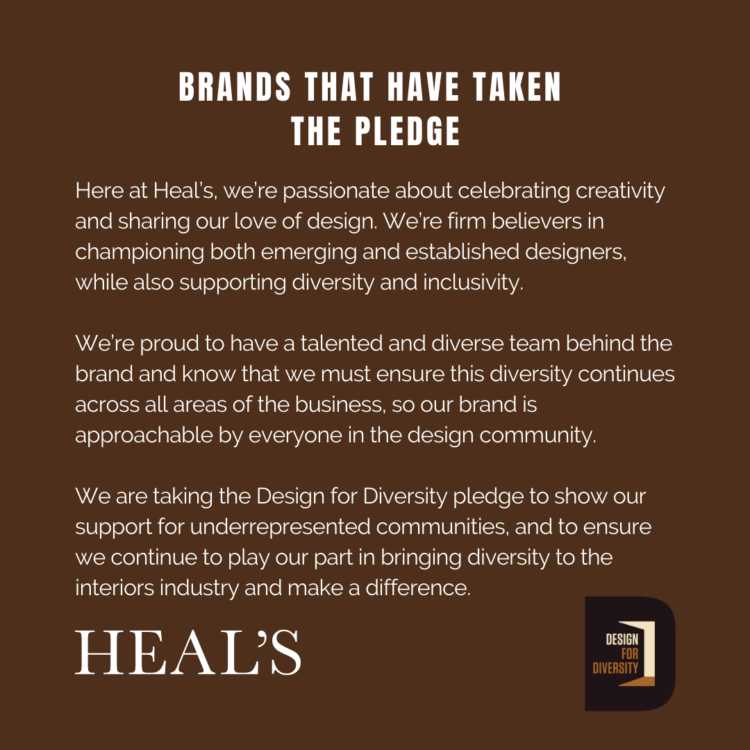
And so Rukmini and I hope that other businesses, on seeing the sticker, will perhaps start talking to each other about offering mentoring, work experience and jobs, hosting events and sourcing products. And on that note, if you are, or aspire to be, an interior designer, then follow Alexandria Dauley, who, in collaboration with Sophie Ashby, is working on an initiative to create a programme of mentoring schemes, open days, apprenticeships and scholarships to reach out to members of the community who may not have considered design as a viable career choice, due to the current lack of diversity, or their own economic challenges.
We hope that it will make black-owned businesses more visible both to each other and to the white community. That this sticker will start a conversation about building bridges, working together and coming up with new ideas.
While we feel that the essential tenets of the pledge shouldn’t change, businesses should be free to add their own top line. It’s also a good way to show other companies how they are embracing the core idea while applying it in ways that make sense to their own business model. Some examples:
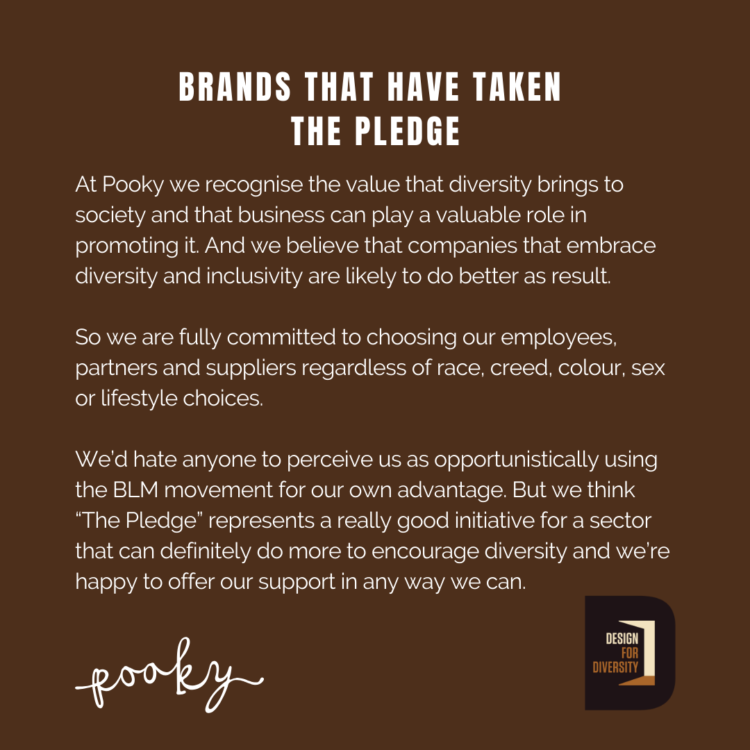
“I’m a stylist and would welcome submissions from people of Black, Asian and Ethnic Minorities who want to assist on shoots and gain experience of the industry. I would also like to work with black photographers as well as learn new places where I might find props.”
“I write a blog, and while I work alone and don’t employ anyone, I stand by the pledge in terms of my content and the events I attend.”
“I run a shop and while I have a range of suppliers and products I would always welcome more submissions and products from Black, Asian and Ethnic Minority designers.”
“I’m a manufacturer and while I have a small highly skilled workforce, I will endeavour to employ more diverse faces at trade shows so my stand may seem more welcoming.”
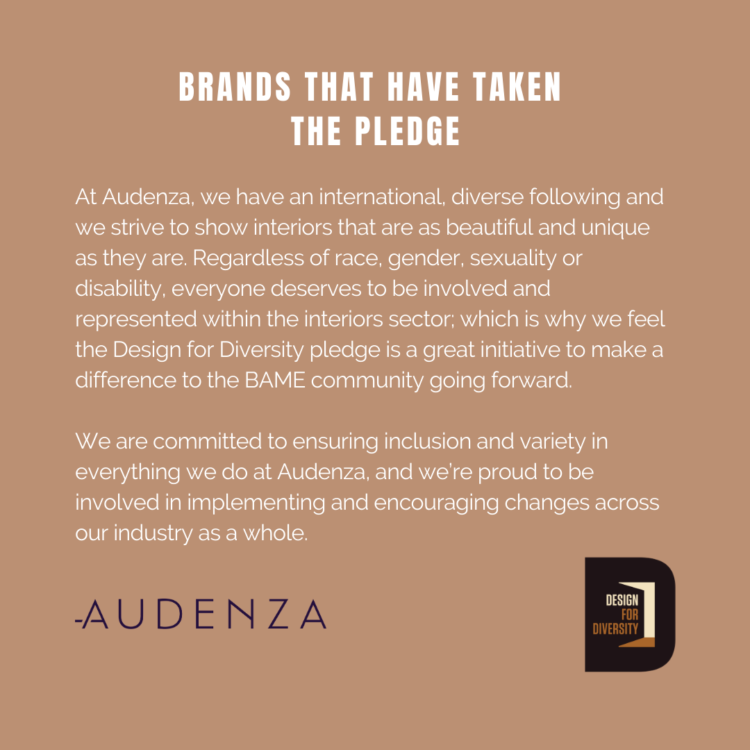
It’s not a solution, and we don’t present it as such. We are, perhaps, throwing a pebble into a pond and hoping it will send out ripples. Or, to put it another way, we are walking into a room full of silent people and offering them a glass of water.
We hope, above all, for diversity in design.
If you would like a sticker and a copy of the pledge that you can customise to suit your own design, please leave a comment or get in touch via the contact form and we will send it all out to you.
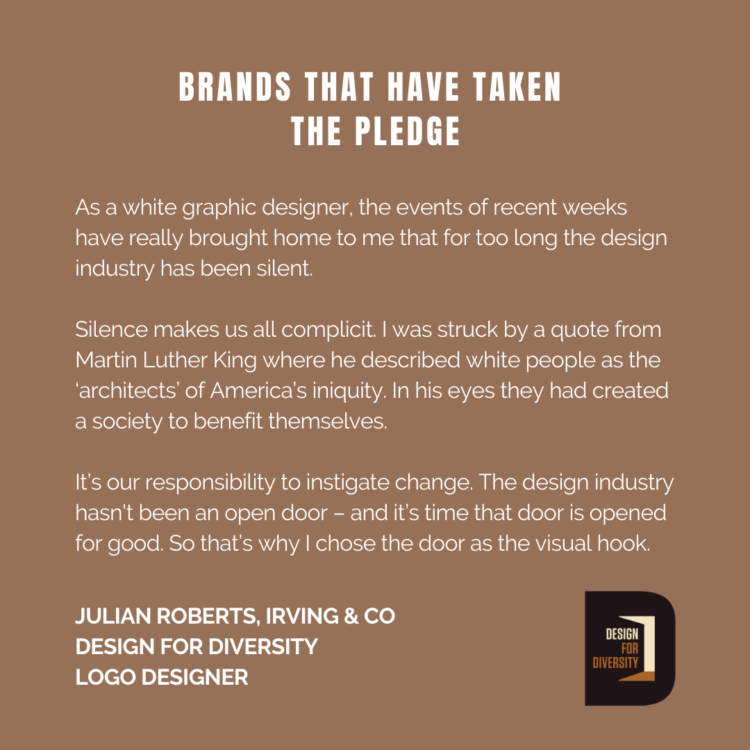
A word about the sticker: It was created by Julian Roberts, of Irving & Co, who I have known for many years. Shortly after speaking to Rukmini, I noticed he had run 25k in memory of Ahmaud Arbery. A kilometre for every year of his life. A life cut short when, while out jogging, he was chased and shot dead by two white men in Brunswick, Georgia. I rang Julian and asked if, in exchange for a donation, he would work with us to create a logo. If you would also like to donate, the link is here but, of course, you may have your own preferred charities and organisations.
The sticker comes in three different colour ways – cream, brown, and as a cut-out, so you can choose whichever one best fits your own website.
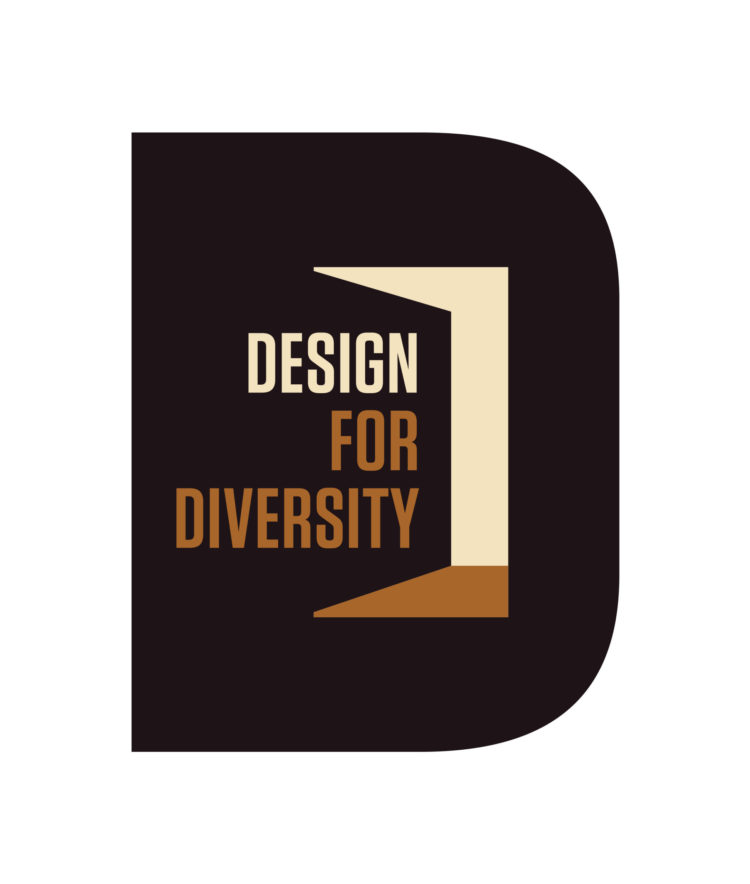 As a final point, it’s important to note that it is also self-regulatory. If you add the sticker you are publicly promising to uphold the ideas therein.
As a final point, it’s important to note that it is also self-regulatory. If you add the sticker you are publicly promising to uphold the ideas therein.
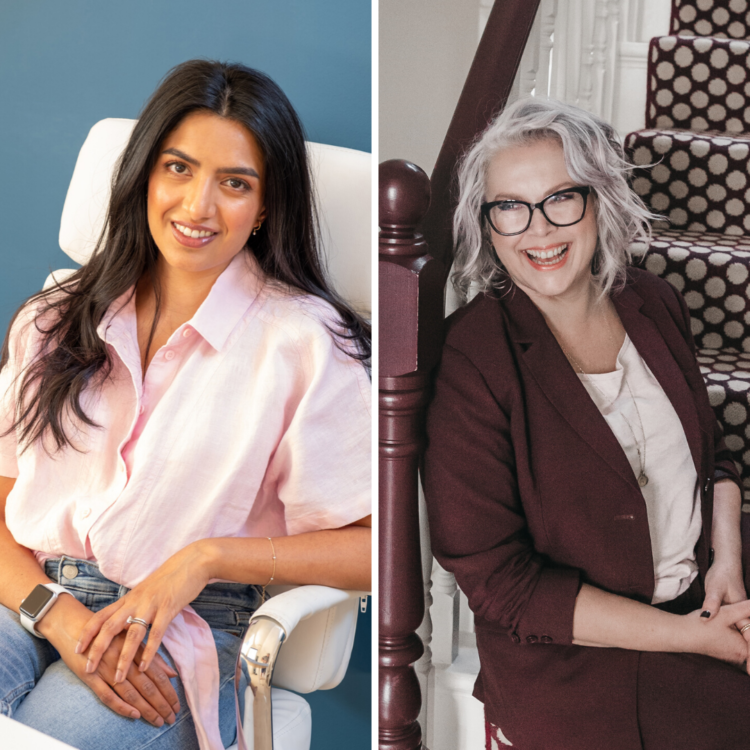
If you would like to join the BAME design community, please take a look at @Bamedesignersproject which will be showcasing BAME design work for potential clients to access.
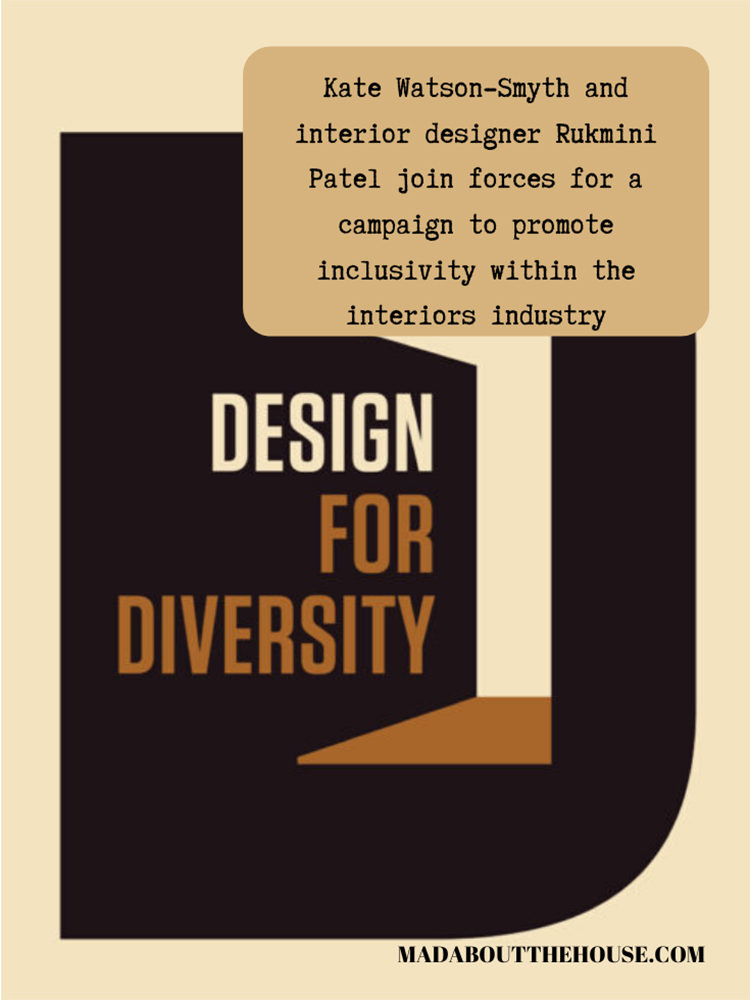

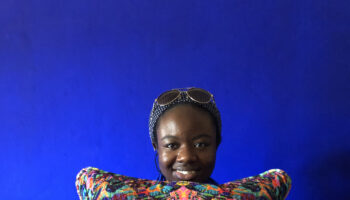
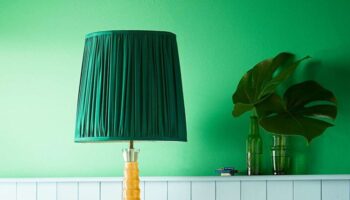
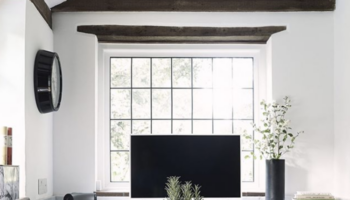


My sisters and I run a family interiors shop. We are white and we live and work in a very white community. We welcome customers of all races, genders, sexualities and backgrounds. We don’t employ anyone (yet) but we are very aware of underrepresentation and when such a time comes that we are able to employ a team, we pledge to ensure it is diverse without tokenism. We feel it is of vital importance to sign up to the pledge and play our part in changing the system. Please can you send us the details?
I will send it all over, thank you for signing up.
Dear Kate,
RE: The Design for Diversity Website Sticker
My name is Nik A Ramli, a fan, and I have two of your books.
I’m an interior designer, author and occasionally I write about interior design tips in publications. I also talk about interior design in Malaysia, for their TV shows most of the time when I’m there.
I would like to request ‘The Design for Diversity Sticker’ to be displayed on my website. This is a great movement in ‘creating opportunities and making a real difference to people’s lives and to the community’. I too have experienced the unfortunate… during my career within the creative world.
Please feel free to browse my website and my other official social media platforms. I hope these sites will allow you to know me a little and to see if I’m suitable to receive the sticker from your organization.
Thank you for your time and waiting to hear from you.
Yours sincerely,
Nik A Ramli
http://www.nikaramli.com
http://www.facebook.com/NikARamliPage
http://www.instagram.com/nikaramli
Fantastic initiative Kate. You say it’s only a ripple, but from small beginnings great things come.
Julian’s logo is absolutely perfect! I love it so much that if I had any pennies at all, I would ask him to design a logo for me.
Great initiative. As you rightly say, it’s about opening doors and starting a long overdue conversation. Change won’t come overnight [too much unconscious bias to shift!] but hopefully the diversity and equality that emerges will be all the more robust and long lasting for having been positively considered and widely embraced. Some great talks on this subject at the Hay on Wye and How the Light Gets In festivals last month. Well worth a watch.
As a senior citizen, I am thrilled that young adults are taking this over due issue on at this time. It is about time. My generation has ignored it’s responsibility on race relations. Time for a change….a BIG one.
What’s great initiative Kate. Super idea. Start of something big I reckon. Hopefully there will be a Domino effect n all barriers come down to make way For a more inclusive future… for everyone 💪💪
Thank you, Kate and Rukmini, for starting this initiative. I am not involved in the design industry, just a retired NHS Manager, who thoroughly enjoys the Mad About the House blog. However, I do have two mixed race Granddaughters. They are only small children currently, but I fervently hope that their futures will not be shaped by their skin colour. Lockdown has given us all time to pause and reflect and I hope and pray that we emerge, post-pandemic, into a better world for everyone. Hopefully, those who sign the pledge will honour their promises.
Hi Kate.
This is a wonderful first steps and initiative that you have started. It’s helps in addressing the ‘what next’ and how change can be constructively started. I so hope that this really is the moment in history that there is real change in the world in all quarters.
At the start of the year seeing the ‘regular’ faces at an overseas event, I told myself that I would be taking myself regardless and that’s somewhat easy for me to say as a 50 year old woman who can handle uncomfortable situations, and rest assured it would have been exactly that. I am a Black woman who felt the only way I could get anywhere in Interiors is to do a degree to somehow even the playing field and elevate me, to then actually find out it won’t ( or hopefully now wouldn’t have) . Then imagine someone much younger and not thicker skinned and used to the racism and what that means , for example my daughter for who’s 21, having to go through experiences that are all negative due to skin colour breaks you. As I and she has the same hopes and dreams as any white parent or child for their future.
It’s great to see people are now actively diversify their feeds but I will also say that it also takes engagement too. Look, engage and buy from our businesses. There is such unknown skill, professionalism and creativity that people are missing out on.
Sophia
Hi Sophia, thank you so much for your support. I feel that the world is ready to change at last and is working out how.